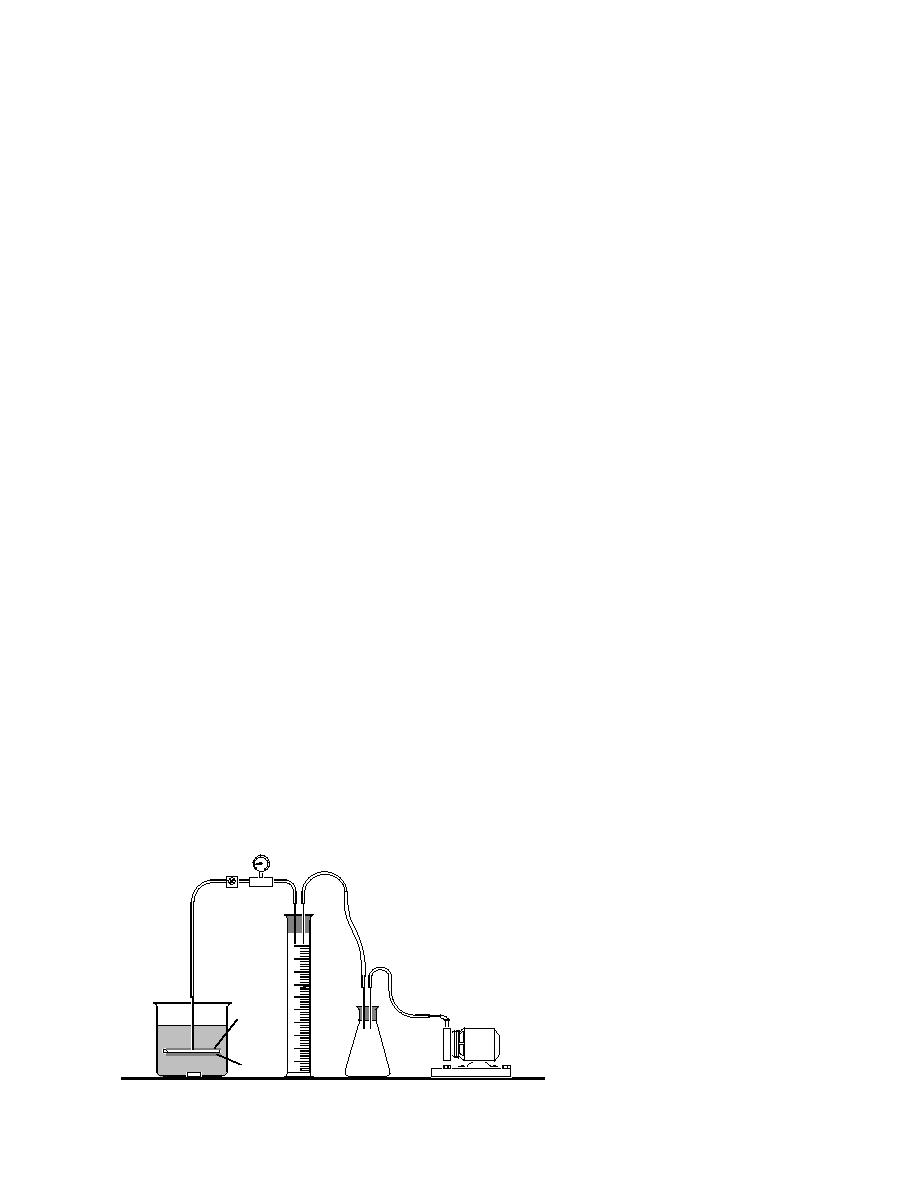
uous process. Both freezing and thawing can be
colloidal humic particles typically present in New
conducted simultaneously. Also, the freezing and
England waters. The specific resistance to filtra-
tion before and after freezethaw was 4.8 109 and
thawing process can be designed so that the heat
6.0 108 s2/g at 38.1 cm of Hg, respectively. This
removed during freezing can be used for thawing.
Therefore, the cost of thawing the sludge should be
reduction in specific resistance indicates an im-
negligible.
provement in filterability due to freezethaw. Capil-
lary section time (CST) tests showed similar results.
CSTs before and after freezethaw were 32 and 6
MATERIALS AND METHODS
seconds, respectively.
Studies were conducted on the two main com-
ponents of the freeze separator: the vacuum filter
Filter leaf tests
and the freezing chamber. The vacuum filter was
The purpose of this test is to determine the opti-
evaluated using the filter leaf test. The freezing
mum design criteria for the vacuum filter compo-
chamber was simulated by freezing layers of
nent of the freeze separator. These criteria are the
sludge in a coldroom.
type of filter cloth, vacuum level and filtration
The alum sludge used in this study was ob-
time. The filter leaf test apparatus was purchased
tained from the water treatment plant in Lebanon,
from Komline Sanderson Engineering Corpora-
New Hampshire. This plant has a design flow of
tion of Peapack, New Jersey. A filter leaf is essen-
15,000 m3/day. Treatment processes include rapid
tially a 0.1-ft2 (0.0093-m2) compartment of a vacu-
mixing, flocculation, sedimentation and sand fil-
um filter made of polypropylene. It resembles a
tration. Chemical additives include potassium per-
flattened funnel onto which a sample of the filter
manganate, alum, powdered activated carbon and
cloth is attached. The filter leaf is submerged in a
sodium bicarbonate. At present the sludge is dis-
container of sludge while a vacuum is applied at
charged to a lagoon where the solids are left to ac-
the other end. A schematic of a typical leaf test ap-
cumulate and the water is allowed to percolate into
paratus is shown in Figure 4.
the ground.
Each filter leaf test proceeded as follows. We se-
For these experiments, we took the settled
lected a filter cloth and attached it to the filter leaf
sludge from the sedimentation basins. We tried to
test apparatus. The filter leaf was immersed in a 6-L
collect the thickest portions in order to reduce the
container of alum sludge, which had a total solids
number of containers. The total solids content of
content ranging from 0.34% to 2.08%. The desired
this sludge was typically 1 to 2%. The sludge was
vacuum was applied to the leaf and maintained
then transported to CRREL and stored in a cold-
throughout the filtration period. To simulate the
room at 0C 2C.
circular motion of a filter cloth through a vat of
sludge, the filter leaf was gently agitated by manu-
The characteristics of alum sludge from the Leba-
ally moving it up and down. Upon completion of
non Water Treatment Plant were examined in a pre-
the filtration period, the filter leaf was removed
vious study (Martel 1988). This study found that
from the container and the sludge layer was al-
the Lebanon sludge had a specific gravity of 1.005
lowed to "form-up" by maintaining vacuum for
and a volatile solids content of 52% (of total solids).
another 30 seconds. The thickness of the layer was
This relatively high volatile solids content is due to
measured with a machinist's ruler, and the cloth was
removed from the filter leaf. The cloth and sludge
Vacuum
Gauge
were then weighed to obtain the weight of wet cake.
Pinch
Clamp
The volume of filtrate was measured with a graduat-
ed cylinder and its turbidity was measured with a
turbidimeter.
To observe the effect of freezing, the cloth and
attached sludge layer were laid in an aluminum
1 Liter
Graduate
Vacuum
Filter
Pump
Leaf
Vacuum
6 Liter
Reservoir
Figure 4. Filter leaf test apparatus.
Sample
Filter
Cloth
6





 Previous Page
Previous Page
